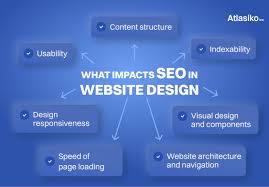
In the digital-first world of business, especially in a vibrant city like Leeds, website design is no longer just about looking good — it’s about functionality, user experience, and search engine optimization (SEO). If you’re a Leeds-based business looking to gain visibility online, understanding how website design directly affects SEO is crucial.
Let’s explore how the design of your website influences how well you rank on Google, how long people stay on your pages, and ultimately how many leads or customers you convert.
1. First Impressions Count — and So Does Bounce Rate
When a visitor lands on your site, you have just a few seconds to make a good impression. A clean, modern, and user-friendly design encourages them to stick around. But if your website is cluttered, slow, or hard to navigate, users will bounce — and high bounce rates send negative signals to search engines.
Key SEO Impact:
Google uses user engagement metrics as ranking factors.
A high bounce rate tells search engines your content or design is not meeting user expectations.
Leeds Insight:
In a competitive local market like Leeds, where hundreds of businesses may be offering similar services, standing out with a functional design can make or break your SEO efforts.
2. Mobile Responsiveness is a Must
Did you know that over 60% of searches now happen on mobile devices? Google operates with a mobile-first indexing approach, meaning your mobile website is what gets evaluated first when determining rankings.
If your Leeds business site isn’t mobile-friendly, you're losing both customers and rankings.
How Website Design Affects SEO Here:
Responsive design ensures your website adjusts seamlessly across different screen sizes.
Poor mobile UX leads to high exit rates, lower engagement, and penalized rankings.
Pro Tip: Use Google’s Mobile-Friendly Test to check your site’s compatibility.
3. Website Speed = Better Rankings + More Conversions
In today’s fast-paced world, users expect websites to load in under 3 seconds. Website speed is a confirmed ranking factor for both desktop and mobile searches.
A well-designed website uses:
Compressed images
Optimized code
Fast hosting
Content Delivery Networks (CDNs)
For Leeds-Based SMEs:
Web speed isn't just about SEO. Local customers searching for restaurants, hair salons, or plumbers want instant results. A slow website leads to lost leads and lower trust.
4. Clean Navigation Helps Crawling and User Experience
Imagine walking into a shop and not knowing where anything is. That’s how users — and search engines — feel when a website’s navigation is poorly designed.
Your navigation should:
Be intuitive and simple
Include important pages in your menu (Home, About, Services, Contact)
Use clear internal linking structures
SEO Benefit:
Well-structured navigation helps Googlebots crawl and index your site efficiently, improving your chances of ranking for relevant keywords.
5. On-Page SEO Elements and Layout
Good website design doesn’t only please the eye — it supports your SEO structure.
Elements Affected by Design:
Title tags & meta descriptions: Easy to implement with proper CMS and theme.
Header tags (H1, H2, H3): Help with content hierarchy and readability.
Alt text for images: Increases image search potential and supports accessibility.
A well-designed site makes it easier for your team (or your SEO expert) to manage and optimise content on an ongoing basis.
6. UX Design Increases Time-on-Site
Search engines reward websites that keep users engaged. When your design includes visual hierarchy, consistent branding, clear CTAs, and readable content, people stick around longer.
Longer Dwell Time = SEO Boost

Leeds-based companies can benefit immensely from this. For example:
A digital agency showcasing case studies
A local café with an interactive menu
An estate agent with a property search tool
These features, if designed well, increase user interaction, which can lead to better rankings and higher conversion rates.
7. Local SEO and Schema Integration
Good design can support local SEO strategies by:
Making location details prominent and clickable
Embedding Google Maps correctly
Structuring your NAP (Name, Address, Phone) info for consistency
Use Local Schema:
Schema markup helps search engines understand the content of your site. A well-designed backend allows easy integration of Local Business schema, which boosts visibility in local search results and Google’s 3-Pack.
8. Security and Trust Signals
Google prefers secure websites. If your site is still running on HTTP instead of HTTPS, your rankings and trust will suffer.
Your design should include:
SSL certificates (HTTPS)
Trust badges
Clear privacy policy and contact details
For local businesses in Leeds, especially those handling payments or personal data, trust signals are crucial both for SEO and user confidence.
9. Content Integration and Visual Design
Your design should complement your content, not overpower it. SEO-rich content needs a platform where it can shine.
Avoid:
Overuse of animations that slow down the site
Walls of text without spacing or imagery
Backgrounds that reduce readability
Instead, use:
Clear CTAs
Visuals and icons that explain complex ideas
Blog sections and case studies to boost organic traffic
A blog or news section is especially helpful for Leeds-based SEO, where writing about local events, partnerships, or community support can drive location-based searches.
10. CMS Choice and SEO Tools
Behind every good design is a powerful CMS (Content Management System). WordPress, Web flow, and Shopify all allow for:
Customizable themes
SEO plugins (like Rank Math, Yoast)
Fast, responsive design
Using a well-structured CMS allows your website to evolve, adapt, and stay SEO-optimized without relying heavily on developers for every minor change.
Final Thoughts: Why It All Matters in Leeds
Leeds is one of the UK’s fastest-growing business hubs. The digital competition here is real — from retail and hospitality to tech startups and professional services.
A well-designed website isn't just about looking good; it’s about getting found, being trusted, and converting visitors into customers. Every design decision, from your homepage layout to your font size, affects your visibility in Google search results.
If your website doesn’t meet modern design and UX standards, you’re likely missing out on organic traffic, regardless of how great your product or service is.
Action Steps for Leeds-Based Businesses:
✅ Audit your website design — is it modern, mobile-friendly, and fast?
✅ Check your core SEO elements: meta tags, headings, image alt text, and internal linking.
✅ Work with local digital marketing experts or SEO consultants who understand the Leeds market.
✅ Regularly update your blog or news section with locally relevant content.
✅ Use tools like Google Search Console and Page Speed Insights to monitor performance.
Need Help?
If you’re a Leeds-based business and unsure where to begin, don’t worry. There are amazing web design and SEO agencies in the city that specialise in helping local companies grow online. Just make sure whoever you choose focuses on both design and performance, not just aesthetics.

